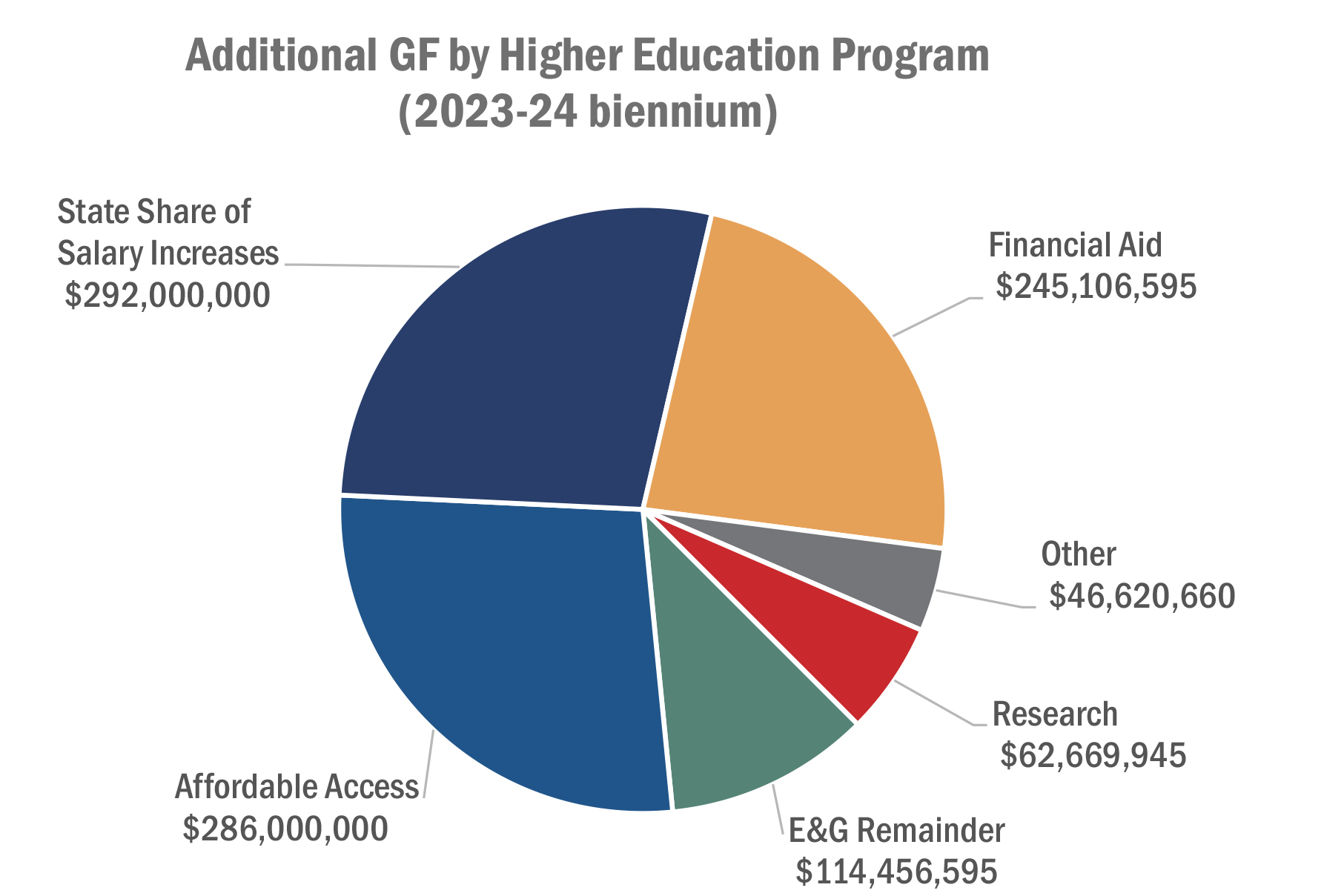This post summarizes the 2022-24 biennial budget for higher education, which took effect July 1, 2022. The introduced budget included additional funding that totaled $924 million--the largest state investment in higher education in a biennium. The conference and Governor’s amendments added more than $122.5 million to that total, resulting in more than $1 billion in new funding for higher education over the biennium. Table 1 provides a break out by program area. Figure 1 shows the division of the total funds over the biennium.
Table 1: Higher Education Additional Appropriations by Program

Of the approximately one-billion dollars of additional appropriations for the biennium, $692 million is provided for Education and General (E&G) support. About $292 million (42%) is dedicated to funding the state’s share of two consecutive years of 5% salary increases for higher education faculty and staff. Salary increases are a shared cost where institutions are required to provide approximately 50% on average, which can result in increased tuition and fees.
Figure 1: Division of Appropriations by Program

Another $286 million of the E&G fund is set aside for affordable access for in-state undergraduate students. These funds intend to moderate the rise of tuition and fees. This investment in tuition moderation aligns with Pathways to Opportunity, the statewide strategic plan for higher education, where one of the three goals is to make higher education in Virginia affordable and to close access and success gaps for low-income Virginians.
In addition to E&G funds, $245 million is allocated for financial aid over the biennium. The largest increase is in undergraduate need-based aid ($20 million in the first year and $130 million in the second year). This investment aligns with SCHEV budget recommendations to address affordability for low- and middle-income families and to increase support at institutions with some of the highest unmet need for these students. As a result, SCHEV estimates an increase in undergraduate need-based aid of 8% in the first year and 45% in the second year over the state supported FY 2022 budget.
The budget also raises the Tuition Assistance Grant (TAG) to $4,500 in the first year and $5,000 in the second year for eligible undergraduate students and graduate programs. (Online students are supported at half of that amount.) An additional $7,500 each year is provided for students attending TAG-eligible Historically Black Colleges and Universities.
Aligning with the equitable goal of Pathways to Opportunity, the budget includes $25 million in the second year for an initiative to enhance strategies that recruit and retain Pell-eligible students.
Research funding (totaling nearly $63 million) primarily focuses on cancer research at University of Virginia and Virginia Commonwealth University. Additional funding is provided in other areas and research institutions, including Virginia Tech and its extension offices, Virginia Institute for Marine Science, Hampton University, Old Dominion University, Jefferson Labs and James Madison University. Other funding is provided to support other entities that support higher education, such as higher education centers, Eastern Virginia Medical School and SCHEV. The General Assembly also approved increased funding for the Innovative Internship Program (known as the Virginia Talent + Opportunity Partnership) at $13 million. (SCHEV recommended $20 million.) These investments align with the transformative goal of the strategic plan.
Other significant appropriations include a $10 million allocation for the Virtual Library of Virginia, which provides online access to academic resources to all public institutions and most private institutions. Another $100 million is allocated in the first year of the biennium to support Lab Schools. From the allocation to lab schools, $25 million is provided for start-up programs with remaining funds distributed to programs on a per-pupil cost basis. Sixty-seven million dollars is appropriated for the Department of Housing and Community Development (in collaboration with SCHEV) for investments in the biotechnology, life sciences and pharmaceutical clusters.
There are other additional budget items involving SCHEV, including a dual enrollment grant program, which seeks to have more dual-enrollment-qualified teachers in high schools, a data science innovation hub in the Hampton Roads area, as well as internal SCHEV staffing needs.
The Takeaway
The increase in funding demonstrates that Virginia remains dedicated to its higher education institutions and continues to work toward making higher education accessible, affordable and transformative for all residents, in accordance with the Pathway to Opportunity Plan. SCHEV's recent report on cost and funding needs found that although Virginia's total funding per student was nearly identical to the national median, Virginia ranks lower at (38th) on state budget support per student. This new investment should improve Virginia's position on this metric. Particularly, the education and general funds provided in the budget aimed at slowing tuition growth, along with the financial aid increases, appeal directly to achieving the “affordable” goal of the Pathway to Opportunity Plan. Other investments including internships and lab schools correspond to the transformative and equitable goals of the strategic plan. SCHEV looks forward to helping policymakers, institutions, and students and families take advantage of the investments made in this historic biennial budget.
Welcome to Insights, SCHEV's platform to interpret and communicate data and policy with the overall goal of informing policy-making, engaging institutions and drawing attention to these resources. Centered around SCHEV's nationally leading data collection, each Insight will visualize complex ideas and help inform funding and policy decisions.
